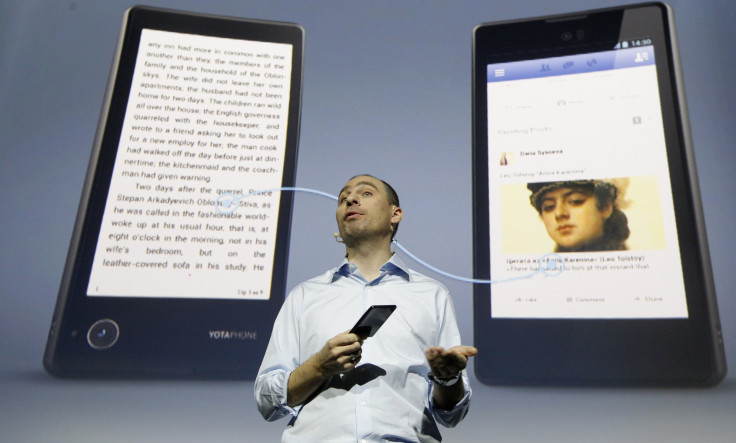YotaPhone Release Date Arrives: Meet Russia's Dual Screen Android Smartphone

St. Petersburg, Russia-based Yota Devices on Wednesday released its Android-based YotaPhone, which features two 4.3-inch screens, including an e-ink display, in five countries in Europe at a price point of about $600 to $700. Yota Devices did not discuss the possibility of a U.S. release, but it did confirm its plans to release the YotaPhone in the Middle East in early 2014.
The biggest difference between Russia’s YotaPhone and most other smartphones is its e-ink screen, which complements the phone’s other full-color 720 x 1280 LCD display. Yota Devices says users can watch videos and play games on the LCD display, but the electronic paper display (EPD) is not only better for reading books and magazines, but it will also extend the battery life of the YotaPhone by transferring applications to the less power-hungry screen.
"The typical user picks up and activates their smartphone more than 150 times a day," said Yota Devices chief executive Vlad Martynov. "Why? Because users worry that messages or information they need or want are hidden behind their phone's black screen. This is a huge distraction and can impede meaningful interaction with our friends, families and colleagues."
The EPD technology helps save battery life on the YotaPhone, but even when its 1,800mAh battery dies -- they all do, eventually -- the YotaPhone will continue to display important information on the e-ink display, such as texts, emails, tickets, maps and boarding passes.
“Information stays on the always-on screen until it is no longer needed,” Martynov said, adding that the YotaPhone has up to 10 times the lasting power of other smartphones thanks to its e-ink display.
Some analysts have called the YotaPhone “ambitious,” because although the second screen might seem like a gimmick, the YotaPhone’s second screen actually provides a function that other smartphones don’t.
“With many smartphone owners struggling to make the battery on their device last a whole day, the option to have a secondary screen that uses little to no power to capture and display a ‘snapshot’ of the main screen could be attractive,” said Ben Wood, a mobile analyst with UK-based research firm CCS Insight.
Always-on dual screens aside, the YotaPhone is powered by a 1.7 GHz dual-core processor with 2 GB of RAM, and it operates on Android 4.2.2 Jelly Bean. The phone itself only weighs 136 grams, which is lighter than the iPhone 4S and just 24 grams heavier than the iPhone 5s, but it comes packed with Wi-Fi and LTE bands, an accelerometer, compass, gyroscope, proximity and ambient light sensor, FM radio, a 1-megapixel front-facing camera on the LCD side and a 13-megapixel camera on the e-ink side of the YotaPhone.
While the first YotaPhone is just seeing its first round of release dates -- the YotaPhone debuts in Germany, France, Russia, Spain and Austria on Wednesday -- Martynov told CNET the company is “working very hard on the second” YotaPhone, which is expected to arrive around the same time next year (late 2014).
"YotaPhone isn't just a new phone, it's a new way for people to communicate and use information," Martynov said. "We are a start-up company that had a big idea and we've executed on that idea. This is YotaPhone 1.0. Expect other big and new things to follow."
© Copyright IBTimes 2024. All rights reserved.






















